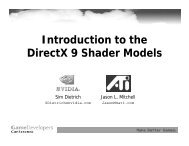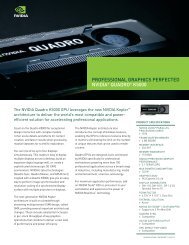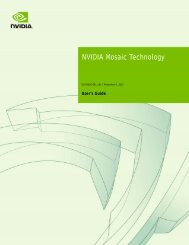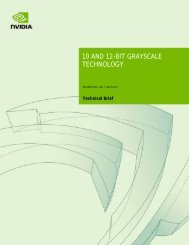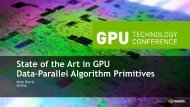CUDA Accelerated Linpack on Clusters - Nvidia
CUDA Accelerated Linpack on Clusters - Nvidia
CUDA Accelerated Linpack on Clusters - Nvidia
You also want an ePaper? Increase the reach of your titles
YUMPU automatically turns print PDFs into web optimized ePapers that Google loves.
<str<strong>on</strong>g>CUDA</str<strong>on</strong>g> <str<strong>on</strong>g>Accelerated</str<strong>on</strong>g> <str<strong>on</strong>g>Linpack</str<strong>on</strong>g> <strong>on</strong> <strong>Clusters</strong><br />
E. Phillips and M. Fatica, NVIDIA Corporati<strong>on</strong> | September 21 2010
Outline<br />
• <str<strong>on</strong>g>Linpack</str<strong>on</strong>g> benchmark<br />
• Tesla T10<br />
– DGEMM Performance / Strategy<br />
– <str<strong>on</strong>g>Linpack</str<strong>on</strong>g> Results<br />
• Tesla T20<br />
– DGEMM Performance / Strategy<br />
– DTRSM<br />
– <str<strong>on</strong>g>Linpack</str<strong>on</strong>g> Results<br />
• C<strong>on</strong>clusi<strong>on</strong>s
LINPACK Benchmark<br />
The LINPACK benchmark is very popular in the HPC<br />
space, because it is used as a performance measure for<br />
ranking supercomputers in the TOP500 list.<br />
The most widely used implementati<strong>on</strong> is the HPL software<br />
package from the Innovative Computing Laboratory at the<br />
University of Tennessee:<br />
it solves a random dense linear system in double<br />
precisi<strong>on</strong> arithmetic <strong>on</strong> distributed-memory computers.
Top500 list
LINPACK Benchmark<br />
Solve a dense NxN linear system:<br />
Ax=b<br />
Soluti<strong>on</strong> is obtained by Gaussian<br />
eliminati<strong>on</strong> with partial pivoting<br />
Floating point workload:<br />
2/3 N^3 + 2 N^2<br />
(LU decompositi<strong>on</strong>) (back solve)<br />
Factorize the current block (red), update the green and yellow parts when d<strong>on</strong>e<br />
The bigger the problem size N is, the more time is spent in the update (DGEMM)
<str<strong>on</strong>g>CUDA</str<strong>on</strong>g> <str<strong>on</strong>g>Accelerated</str<strong>on</strong>g> LINPACK<br />
Both CPU cores and GPUs are used in synergy with minor<br />
or no modificati<strong>on</strong>s to the original source code (HPL 2.0):<br />
- An host library intercepts the calls to DGEMM and<br />
DTRSM and executes them simultaneously <strong>on</strong> the GPUs<br />
and CPU cores.<br />
- Use of pinned memory for fast PCI-e transfers, up to<br />
5.7GB/s <strong>on</strong> x16 gen2 slots. Only changes to the HPL<br />
source
NVIDIA Tesla GPU Computing Products
DGEMM: C = alpha A B + beta C<br />
DGEMM(A,B,C) = DGEMM(A,B1,C1) U DGEMM(A,B2,C2)<br />
(GPU)<br />
(CPU)<br />
The idea can be extended to multi-GPU c<strong>on</strong>figurati<strong>on</strong> and to handle huge matrices<br />
Find the optimal split, knowing the relative performances of the GPU and CPU cores <strong>on</strong> DGEMM
Overlap DGEMM <strong>on</strong> CPU and GPU<br />
// Copy A<br />
cublasSetMatrix (m, k , sizeof(A[0]), A, lda, devA, m_gpu);<br />
// Copy B1<br />
cublasSetMatrix (k ,n_gpu, sizeof(B[0]), B, ldb, devB, k_gpu);<br />
// Copy C1<br />
cublasSetMatrix (m, n_gpu, sizeof(C[0]), C, ldc, devC, m_gpu);<br />
// DGEMM <strong>on</strong> GPU<br />
// C<strong>on</strong>trol returns immediately to CPU<br />
cublasDgemm('n', 'n', m, n_gpu, k, alpha, devA, m,devB, k, beta, devC, m);<br />
// DGEMM <strong>on</strong> CPU<br />
dgemm('n','n',m,n_cpu,k, alpha, A, lda,B+ldb*n_gpu, ldb, beta,C+ldc*n_gpu, ldc);<br />
// Copy C1<br />
status = cublasGetMatrix (m, n, sizeof(C[0]), devC, m, C, *ldc);<br />
Using <str<strong>on</strong>g>CUDA</str<strong>on</strong>g>, it is very easy to express the workflow in the diagram
Optimal split<br />
If A(M,K), B(K,N) and C(M,N), a DGEMM call performs 2*M*K*N operati<strong>on</strong>s<br />
T CPU (M,K,N2) = T GPU (M,k,N1)<br />
N=N1+N2<br />
If G CPU denotes the DGEMM performance of the CPU in Gflops and G GPU the <strong>on</strong>e of the GPU,<br />
The optimal split is<br />
G GPU / (G CPU +G GPU )
DGEMM performance <strong>on</strong> GPU (T10)<br />
A DGEMM call in CUBLAS maps to several different kernels depending <strong>on</strong> the size<br />
With the combined CPU/GPU approach, we can always send optimal work to the GPU.<br />
M K N M%64 K%16 N%16 Gflops<br />
448 400 12320 Y Y Y 82.4<br />
12320 400 1600 N Y Y 75.2<br />
12320 300 448 N N Y 55.9<br />
12320 300 300 N N N 55.9<br />
Tesla T10 1.44Ghz, data resident in GPU memory. Optimal kernel achieves 95% of peak
128<br />
320<br />
512<br />
704<br />
896<br />
1088<br />
1280<br />
1472<br />
1664<br />
1856<br />
2048<br />
2240<br />
2432<br />
2624<br />
2816<br />
3008<br />
3200<br />
3392<br />
3584<br />
3776<br />
3968<br />
4160<br />
4352<br />
4544<br />
4736<br />
4928<br />
5120<br />
5312<br />
5504<br />
5696<br />
5888<br />
6080<br />
DGEMM Performance<br />
120<br />
100<br />
80<br />
GFLOPs<br />
60<br />
40<br />
20<br />
Xe<strong>on</strong> Quad-core 2.8 GHz, MKL 10.3<br />
Tesla C1060 GPU (1.296 GHz)<br />
CPU + GPU<br />
0<br />
Size
Results <strong>on</strong> workstati<strong>on</strong><br />
SUN Ultra 24 workstati<strong>on</strong> with an Intel Core2 Extreme Q6850<br />
(3.0Ghz) CPU, 8GB of memory plus a Tesla C1060 (1.296Ghz) card.<br />
-Peak DP CPU performance of 48 GFlops<br />
-Peak DP GPU performance of 77 Gflops (60*clock)<br />
T/V N NB P Q Time Gflops<br />
--------------------------------------------------------------------------------------------------<br />
WR00L2L2 23040 960 1 1 97.91 8.328e+01<br />
---------------------------------------------------------------------------------------------------<br />
||Ax-b||_oo/(eps*(||A||_oo*||x||_oo+||b||_oo)*N)= 0.0048141 ...... PASSED<br />
83.2 Gflops sustained <strong>on</strong> a problem size using less than 4GB of memory: 66% of efficiency<br />
T/V N NB P Q Time Gflops<br />
--------------------------------------------------------------------------------<br />
WR00C2R2 32320 1152 1 1 246.86 9.118e+01<br />
--------------------------------------------------------------------------------<br />
||Ax-b||_oo/(eps*(||A||_oo*||x||_oo+||b||_oo)*N)= 0.0042150 ...... PASSED<br />
91.1 Gflops sustained <strong>on</strong> a problem size using 8GB of memory: 73% of efficiency
PCI-e transfer speed<br />
SUN Ultra 24<br />
PCI-e x16 gen2<br />
Pageable Pinned<br />
Memory Memory<br />
Supermicro 6016GT<br />
PCI-e x16 gen2<br />
Pageable Pinned<br />
Memory Memory<br />
H2D<br />
2132 MB/s 5212 MB/s 4665 MB/s 5745 MB/s<br />
D2H<br />
1882 MB/s 5471 MB/s 4064 MB/s 6059 MB/s<br />
<str<strong>on</strong>g>CUDA</str<strong>on</strong>g> offers a fast PCI-e transfer when host memory is allocated with cudaMallocHost<br />
instead of regular malloc.
Effect of PCI-e bandwidth<br />
Page locked memory<br />
T/V N NB P Q Time Gflops<br />
--------------------------------------------------------------------------------------------------<br />
WR00L2L2 23040 960 1 1 97.91 8.328e+01<br />
---------------------------------------------------------------------------------------------------<br />
||Ax-b||_oo/(eps*(||A||_oo*||x||_oo+||b||_oo)*N)= 0.0048141 ...... PASSED<br />
Pageable memory<br />
T/V N NB P Q Time Gflops<br />
--------------------------------------------------------------------------------------------------<br />
WR00L2L2 23040 960 1 1 117.06 6.966e+01<br />
---------------------------------------------------------------------------------------------------<br />
||Ax-b||_oo/(eps*(||A||_oo*||x||_oo+||b||_oo)*N)= 0.0048141 ...... PASSED
Results <strong>on</strong> cluster<br />
Cluster with 8 nodes, each node c<strong>on</strong>nected to half of a Tesla S1070-500 system:<br />
-Each node has 2 Intel Xe<strong>on</strong> E5462 ( 2.8Ghz with 1600Mhz FSB) , 16GB of<br />
memory and 2 GPUs (1.44Ghz clock).<br />
-The nodes are c<strong>on</strong>nected with SDR Infiniband.<br />
T/V N NB P Q Time Gflops<br />
---------------------------------------------------------------------------------------------------<br />
WR11R2L2 118144 960 4 4 874.26 1.258e+03<br />
----------------------------------------------------------------------------------------------------<br />
||Ax-b||_oo/(eps*(||A||_oo*||x||_oo+||b||_oo)*N)= 0.0031157 ...... PASSED<br />
1.258 Tflop/s sustained using 8GB of memory per MPI process.<br />
The first system to break the Teraflop barrier was ASCI Red (1.068 Tflop/s) in June 1997 with<br />
7264 Pentium Pro processors. The GPU accelerated nodes occupies 8U ( 11U including<br />
Ethernet and Infiniband switches).
FERMI T20 GPU
T20 (Fermi) Architecture<br />
• Increased DP Throughput<br />
— 515 GFLOPS *PEAK* vs 85 GFLOPS T10<br />
— Theoretical 75% DGEMM : 515 x .75 = 386 GFLOPS<br />
• Cache Heirarchy<br />
— 64KB c<strong>on</strong>figurable L1 + shared memory (48/16 or 16/48)<br />
— 768 KB unified L2<br />
— Load/Store architecture<br />
• Dual Copy Engines<br />
— Overlap both download and upload of data with compute<br />
— Support Asynchr<strong>on</strong>ous 2D data transfers
T10 DGEMM<br />
16<br />
• T10 DGEMM algorithm (Volkov)<br />
— 64 Threads 64x16 of C<br />
— B reuse in shared memory<br />
— A loaded from global memory<br />
— DP limited <strong>on</strong> T10<br />
• DP 8x slower than other instructi<strong>on</strong>s<br />
• T20 DP full speed<br />
— T10 DGEMM runs 175 GFLOPS<br />
— Different Bottlnecks<br />
64<br />
A<br />
16<br />
16<br />
B<br />
C
T20 DGEMM<br />
• 16x16 Threads update 64x64 of C<br />
• Instructi<strong>on</strong> throughput bottleneck<br />
— Maximize Density of DFMA instrucit<strong>on</strong>s<br />
— Register Blocking<br />
— Use wide vector Loads (128 bits)<br />
— DFMA dual issues with Texture<br />
• Texture fetch A and B<br />
• Hide Latencies<br />
— Double Buffer Shared Memory<br />
64<br />
A<br />
16<br />
16<br />
B<br />
C<br />
64
T20 DGEMM Performance<br />
• Inner Loop<br />
— Multiply 4x4 elements per thread<br />
— 4 Loads (128-bit), 16 DFMA = 80%<br />
• Outer Loop (16 iterati<strong>on</strong>s)<br />
— 256 DFMA / 341 instructi<strong>on</strong> = 75 %<br />
• <str<strong>on</strong>g>CUDA</str<strong>on</strong>g> code ~ 301 GFLOPS<br />
— General – all c<strong>on</strong>figs – all sizes<br />
• <str<strong>on</strong>g>Linpack</str<strong>on</strong>g> versi<strong>on</strong> ~360 GFLOPS<br />
— NT c<strong>on</strong>fig, M%64, N%64, K%16<br />
— 360/515 = 70% 360/386 = 93%
T20 DGEMM Efficiency<br />
• Why T20 DGEMM 70% PEAK < T10 95% PEAK ?<br />
— Faster compute exposes other bottlenecks<br />
• Compare with T10 SGEMM<br />
— T10 622 GFLOPS peak MAD<br />
— 2x Effective resources: bandwidth (102 GB/s *2 = 204 GB/s)<br />
— SGEMM performance: 400 GFLOPS (Hand Code)<br />
— 400 / 622 = 64%
DGEMM Compute/COPY Analysis
DGEMM Analysis<br />
• K~1000,PCIe=6GB/s<br />
100 GFLOPS= ~88%<br />
300 GFLOPS= ~70%<br />
500 GFLOPS= ~60%<br />
• Larger K increases<br />
compute intensity<br />
• Overlapping Copy<br />
Benefit increases<br />
with GPU Perf
Fermi DGEMM Strategy<br />
• Slice Matrix into several pieces<br />
• Use Stream API<br />
— Overlap COPY + Compute<br />
Copy A H2D<br />
Loop over pieces:<br />
Copy Bi,Ci H2D<br />
DGEMM A,Bi,Ci<br />
Copy Ci D2H<br />
CPU DGEMM A,B_last,C_last
DGEMM Compute/Copy Overlap
Additi<strong>on</strong>al Overlap strategy<br />
• Copy A matrix can<br />
be significant for<br />
smaller matrix sizes<br />
• Split A for<br />
additi<strong>on</strong>al Overlap
GFLOPS<br />
Fermi DGEMM Performance<br />
500<br />
450<br />
400<br />
350<br />
435 CPU+GPU<br />
350 GPU<br />
300<br />
250<br />
200<br />
150<br />
100<br />
Dual Quad-Core Xe<strong>on</strong> X5550 2.66 GHz 8 cores MKL 10.2.4.032<br />
Tesla M2050 "Fermi" 1.15 GHz<br />
CPU + GPU<br />
85 CPU<br />
50<br />
0<br />
0 2000 4000 6000 8000 10000 12000 14000 16000 18000<br />
Size: N=M (K=1024)
Optimizati<strong>on</strong>s – Auto Split<br />
• Keep track of CPU and GPU performance and adjust split<br />
— Wallclock() CPU time<br />
— Cuda event record GPU time<br />
— Compute optimal split for next iterati<strong>on</strong><br />
cudaEventRecord(GPU_start,0);<br />
Loop: launch GPU copys + Kernels<br />
cudaEventRecord(GPU_stop,0);<br />
CPU_start = wallclock();<br />
Call CPU_DGEMM<br />
CPU_stop = wallclock();<br />
cudaEventSynchr<strong>on</strong>ize(GPU_stop);<br />
GPU_GFLOPS = GPU_FLOPS/GPU_TIME<br />
CPU_GFLOPS = CPU_FLOPS/CPU_TIME<br />
SPLIT = GPU_GFLOPS/(GPU_GFLOPS+CPU_GFLOPS)
DTRSM<br />
• Triangular Solve with Multiple RHS<br />
— AX=B<br />
— B overwritten with soluti<strong>on</strong> X<br />
• Same CPU/GPU work Split strategy as DGEMM<br />
• GPU DTRSM Blocked Algorithm<br />
— Customized DTRSM Kernel <strong>on</strong> diag<strong>on</strong>al 64x64 blocks of A<br />
— Propagate to next row block of B with DGEMM<br />
— Take advantage of Hand Code DGEMM Kernel performance
DTRSM<br />
Same basic splitting approach as DGEMM
DTRSM<br />
• GPU implimentati<strong>on</strong> based <strong>on</strong> blocked DGEMM update<br />
• First compute diag<strong>on</strong>al block of A / Row block of B
DTRSM<br />
• GPU implimentati<strong>on</strong> based <strong>on</strong> blocked DGEMM update<br />
• First compute diag<strong>on</strong>al block of A / Row block of B<br />
• DGEMM update next row B with n<strong>on</strong>-diag<strong>on</strong>al row of A<br />
A’<br />
B’<br />
C’
DTRSM<br />
• Repeat:<br />
• DTRSM diag<strong>on</strong>al block
DTRSM<br />
• Repeat:<br />
• DTRSM diag<strong>on</strong>al block, then DGEMM update next row block<br />
B’<br />
A’<br />
C’
DTRSM<br />
• C<strong>on</strong>tinue until all rows have been processed
Results <strong>on</strong> single node<br />
Supermicro 6016GT-TF: Dual Intel Xe<strong>on</strong> X5560 Nehalem 2.8 GHz<br />
96GB memory, 1 or 2 Tesla M2050 1.15Ghz cards<br />
-Peak DP 89 + 515 = 604 GFLOPS<br />
-DGEMM 89 + 350 = 439 GFLOPS<br />
================================================================================<br />
T/V N NB P Q Time Gflops<br />
--------------------------------------------------------------------------------<br />
WR10L2L2 108032 768 1 1 2011.42 4.179e+02<br />
--------------------------------------------------------------------------------<br />
||Ax-b||_oo/(eps*(||A||_oo*||x||_oo+||b||_oo)*N)=<br />
0.0039415 ...... PASSED<br />
================================================================================<br />
417.9 GFLOPS = 69% of *PEAK* or 95% of *DGEMM*<br />
2 Tesla<br />
M2050 GPUs<br />
================================================================================<br />
T/V N NB P Q Time Gflops<br />
--------------------------------------------------------------------------------<br />
WR10L2L2 108032 768 1 2 1192.13 7.051e+02<br />
--------------------------------------------------------------------------------<br />
||Ax-b||_oo/(eps*(||A||_oo*||x||_oo+||b||_oo)*N)=<br />
0.0040532 ...... PASSED<br />
================================================================================<br />
SuperServer 6016GT-TF<br />
2 CPUs + 2 GPUs in 1U<br />
705.1 GFLOPS = 63% of *PEAK* or 89% of *DGEMM*
Single Node <str<strong>on</strong>g>Linpack</str<strong>on</strong>g> Performance<br />
750<br />
600<br />
450<br />
300<br />
Performance<br />
Gflops<br />
656.1<br />
70<br />
60<br />
50<br />
40<br />
30<br />
Performance / $<br />
Gflops / $K<br />
60<br />
800<br />
600<br />
400<br />
Performance / watt<br />
Gflops / kwatt<br />
656<br />
150<br />
80.1<br />
20<br />
10<br />
11<br />
200<br />
146<br />
0<br />
CPU Server<br />
GPU-CPU<br />
Server<br />
0<br />
CPU Server<br />
GPU-CPU<br />
Server<br />
0<br />
CPU Server GPU-CPU<br />
Server<br />
CPU 1U Server: 2x Intel Xe<strong>on</strong> X5550 (Nehalem) 2.66 GHz, 48 GB memory, $7K, 0.55 kw<br />
GPU-CPU 1U Server: 2x Tesla C2050 + 2x Intel Xe<strong>on</strong> X5550, 48 GB memory, $11K, 1.0 kw
<str<strong>on</strong>g>Linpack</str<strong>on</strong>g> Score (GFLOPS)<br />
Effect of Problem Size (memory size)<br />
• Memory use ~<br />
8 bytes*N*N<br />
1400<br />
1200<br />
1000<br />
• More memory<br />
increases<br />
performance<br />
and efficiency<br />
800<br />
600<br />
400<br />
200<br />
1 node<br />
4 node<br />
0<br />
0 10000 20000 30000 40000 50000 60000 70000 80000<br />
Problem Size (N)
Cluster Performance<br />
CASPUR Jazz Cluster<br />
Node 16x HP DL360 G7 Interc<strong>on</strong>nect Infiniband QDR<br />
CPU 2x X5650 @ 2.67 GHz (6 cores) Switch HP (Voltaire) 36P Managed Switch<br />
RAM 48 GB HCA HP InfiniBand 4X QDR C<strong>on</strong>nectX-2 PCIe G2 Dual Port<br />
Peak Perf. 1152 GFLOPS (DP) GPU NVIDIA S2050 (half x node)<br />
xHPL Perf. 892 GFLOPS (DP) (2x GPUs C2050 @ 1.15 GHz & 3 GB DDR5 RAM)<br />
Notes MKL_NUM_THREADS = 6 /CPU OMPL_NUM_THREADS = 6 /CPU<br />
Infiniband QDR as OpenIB no RDMA<br />
GFLOPS: best results per # Procs<br />
mpirun -mca tbl openib,self -mca btl_openib_flags 1 -bysocket -bind-to-socket -hostfile ./myhostfile -np #Procs ./run_linpack<br />
GFLOPS<br />
#Nodes #Procs PxQ N MemTot(MB) MemNode(MB) Nb=768 x Node % xHPL % peak<br />
1 1 1x1 70000 41870 41870 410 410 80.6% 64.4%<br />
1 2 1x2 70000 41870 41870 640 640 71.7% 55.6%<br />
2 4 2x2 105000 94208 47104 1319 660 73.9% 57.2%<br />
4 8 2x4 150000 192261 48065 2551 638 71.5% 55.4%<br />
6 12 3x4 180000 276855 46143 3814 636 71.3% 55.2%<br />
8 16 4x4 210000 376831 47104 5092 637 71.4% 55.3%<br />
10 20 4x5 235000 471893 47189 6295 630 70.6% 54.6%<br />
12 24 4x6 256000 560000 46667 7498 625 70.0% 54.2%<br />
14 28 4x7 280000 669922 47852 8771 627 70.2% 54.4%<br />
15 30 5x6 290000 718628 47909 9147 610 68.4% 52.9%<br />
16 32 4x8 300000 769043 48065 10050 628 70.4% 54.5%
Nebulae Cluster<br />
#2 <strong>on</strong> Latest Top500<br />
4640 Tesla T20 GPUs<br />
1.271 PetaFlops<br />
T/V N NB P Q Time Gflops<br />
-------------------------------------------------------------------------------------------------<br />
WR13C2L4 2359296 768 32 145 6886.10 1.271e+06<br />
--------------------------------------------------------------------------------------------------<br />
||Ax-b||_oo/(eps*(||A||_oo*||x||_oo+||b||_oo)*N)= 0.0033806 ...... PASSED
Megaflops/watt<br />
Cluster Performance / Watt<br />
GPU<br />
X86
Future Challenges<br />
• Compute growing faster than bandwidths<br />
— System Memory, PCIe, Network<br />
• Optimize HPL code to reduce GPU idle time<br />
— Pipeline swap / update<br />
• Dynamic Task Scheduling / Load Balancing<br />
— PLASMA / MAGMA / StarPU<br />
— Task Dependency Graph / Performance Models
C<strong>on</strong>clusi<strong>on</strong>s<br />
• Easy to accelerate the <str<strong>on</strong>g>Linpack</str<strong>on</strong>g> performance of workstati<strong>on</strong>s<br />
and clusters using Tesla and <str<strong>on</strong>g>CUDA</str<strong>on</strong>g><br />
• Increasing the performance per node reduces the cost of<br />
high performance interc<strong>on</strong>nects <strong>on</strong> clusters<br />
• Improved Power Efficiency<br />
• Code is available from NVIDIA



